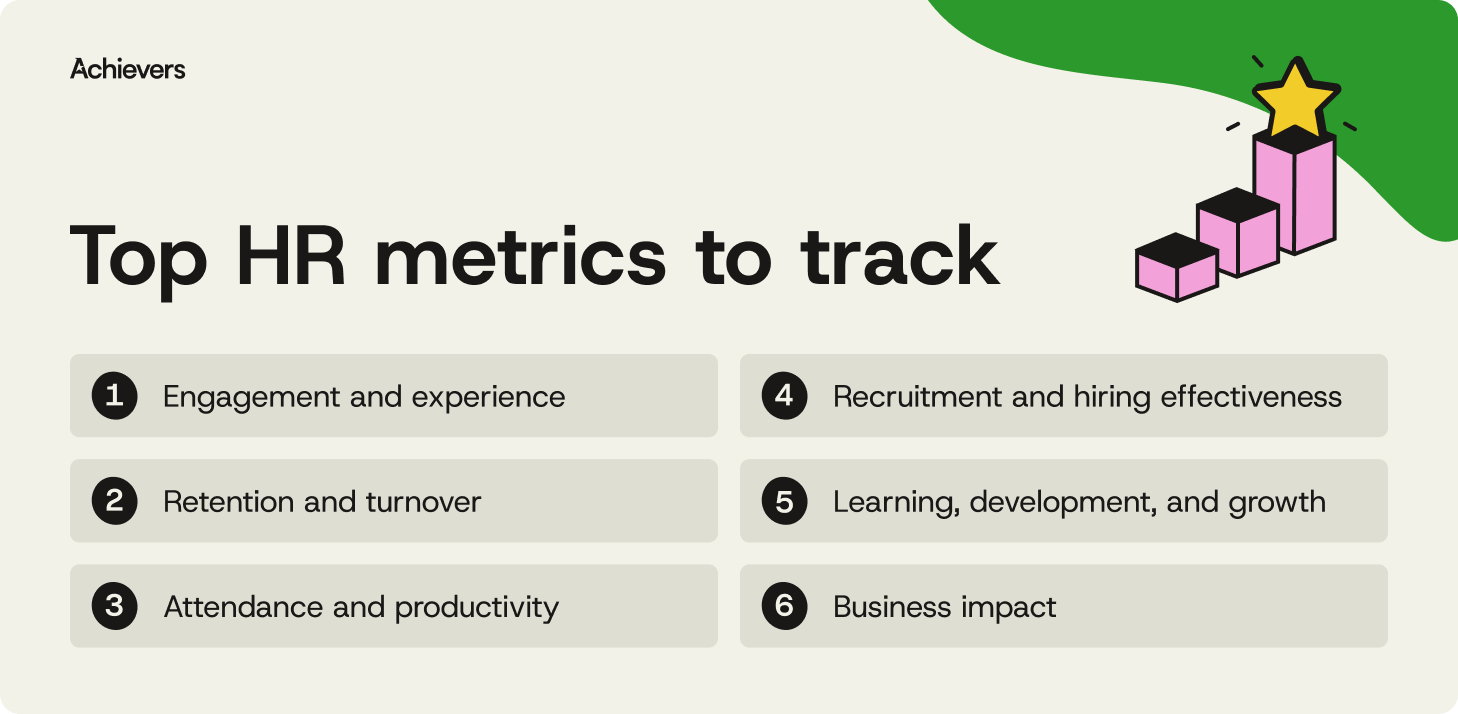Table of contents
Create a culture that means business™
Schedule a demo with an Achievers solution expert today.
HR metrics have a reputation for being all charts and no heart. But when used well, they’re one of the most powerful tools for building a high-performing, people-first workplace. The most effective HR teams go beyond the numbers — they look for the signals that show whether employees feel connected, supported, and seen.
Recognition frequency, engagement scores, and internal mobility rates reveal what’s really happening in your culture. When you focus on the right metrics, you’re not just reporting outcomes — you’re influencing them.
In this blog, we’ll unpack the HR metrics that matter most — and how the right recognition platform helps you move from tracking to transforming. Because when you measure what matters, you don’t just see results — you shape them.
Top HR metrics to track and measure
There’s no shortage of data out there — but not every number is worth your time. They highlight what’s working, what needs attention, and where your strategy might need a nudge (or a full-on rethink).
Each category offers a different lens — and when you put them together, you get a clearer picture of what it actually feels like to work at your organization.

1. Employee engagement and experience
Engagement isn’t about smiley-face surveys or annual check-ins — it’s about whether people feel like they belong, like their work matters, and like someone would notice if they found another job tomorrow. It’s also one of the clearest indicators of how well your culture is functioning day to day.
To get a real read, keep an eye on:
- Employee engagement score: Regular employee surveys and eNPS results give you a read on motivation, connection, and commitment.
- Recognition frequency and reach: Track how often people are being recognized — and just as important, who’s being left out.
- Program participation: Look at who’s opting into wellness, learning, and volunteering opportunities. If no one’s showing up, that tells you something.
- Inclusion and belonging scores: DEI-focused surveys reveal whether people feel seen, supported, and safe being themselves.
2. Retention and turnover
It’s one thing to attract great talent — it’s another to keep it. Retention metrics help you understand why people leave, who’s staying, and whether your culture is one they actually want to grow with. And while some turnover is natural, losing your best people (or half your new hires before year one) is usually a red flag waving in plain sight.
Here are the key metrics to watch:
- Voluntary turnover rate: Looks at the rate of people who leave by choice, not due to layoffs or restructuring. High numbers could signal cultural issues, lack of growth, or better offers elsewhere.
- Regrettable loss rate: Looks specifically at high performers who leave. If these numbers climb, it’s time to dig into what — or who — you’re not retaining. In cultures where quiet cutting replaces honest dialogue, even top talent can lose motivation fast.
- First-year retention rate: Measures how many new hires make it past their first year. It’s a strong indicator of onboarding success, culture fit, and overall engagement.
- Internal mobility rate: Shows how often employees are promoted or make lateral moves. When mobility is high, it usually means people see a future with you.
3. Attendance and productivity
No one’s expecting perfect attendance — we’re all human. But tracking when and how often employees miss work (or show up without actually being present) gives you early clues about workplace burnout, disengagement, and team morale. Productivity metrics, meanwhile, help you understand whether people have what they need to do their best work — or if they’re quietly drowning in unclear goals and broken processes.
Here’s what to keep an eye on:
- Absence rate: Tracks unplanned time off like sick days or last-minute leave. A steady rise might suggest burnout, stress, or a culture that punishes presence over well-being.
- Presenteeism indicators: Looks at signs that people are physically at work but mentally checked out — like chronic low performance or skipping engagement surveys altogether.
- Overall performance metrics: Includes goal completion rates, manager feedback, and team-level outcomes. These help separate actual blockers from “just having a rough week.”
4. Recruitment and hiring effectiveness
Hiring doesn’t end when someone signs the offer letter. These metrics help you figure out whether your recruitment process is bringing in the right people, fast enough, and at a cost that makes sense. More importantly, they tell you if those new hires are actually sticking around and contributing — or quietly questioning their decision by week two.
Here’s where to focus:
- Time-to-fill: Captures the full length of your hiring process, from job listing to offer acceptance. If it’s dragging, you may be losing great candidates to faster-moving competitors.
- Cost-per-hire: Adds expenses like advertising, recruiter fees, and onboarding. It’s a good check on how efficient (or bloated) your hiring funnel really is.
- Quality of hire: Looks at how well new hires perform, contribute, and stick around. This is where talent meets culture — and where bad fits tend to show up fast.
5. Learning, development, and growth
Growth shouldn’t be a guessing game. If you want employees to stick around, they need to see a path forward — and feel like the organization is investing in their future, not just their output. These metrics help you understand whether people are gaining skills, hitting development milestones, and actually using what they learn.
Keep tabs on these:
- Skills development participation: Tracks who’s enrolling in training or upskilling programs. Low numbers might mean people don’t see the value — or don’t have the time.
- Completion rates for development programs: Measures how many employees actually finish what they start. If people keep bailing halfway through, something’s off.
- Recognition tied to development milestones: Looks at how often employees are recognized for learning new skills, earning certifications, or taking on stretch projects.
6. Business impacts
This is where people data meets business results. Metrics in this category show how culture, recognition, and engagement drive performance. And the connection is clear — 91% of employees who are meaningfully recognized at least monthly are very engaged at work, according to Achievers Workforce Institute (AWI).
Focus on metrics like:
- Impact of recognition on engagement and retention: Tracks how recognition programs influence key people metrics over time — including turnover and survey scores.
- Connection between recognition and productivity: Looks at how behavior-based recognition connects with KPIs like goal achievement or revenue per employee.
- Cultural alignment metrics: Measures how often employees are recognized for values-aligned behaviors — a solid indicator of whether your culture is lived, not just laminated.
How to move from measuring to improving HR metrics
Tracking HR metrics is a solid start — but numbers alone won’t change anything. The real value comes from what you do with the data. Otherwise, you’re just collecting receipts for a culture you’re not actively shaping.
This is where the right recognition platform earns its keep — helping you connect the dots between data and day-to-day decisions. A platform like Achievers brings it all together: real-time insights, behavior-based recognition, and tools that meet people where they are.
Here’s how to close the loop between metrics and action:
- Set clear goals based on your metrics: Whether you’re aiming to boost recognition frequency, reduce regrettable turnover, or increase value-aligned behaviors, Achievers gives you the tools to define success and measure it clearly. Flexible reporting and real-time dashboards let you track progress by team, location, or business unit — without drowning in spreadsheets.
- Identify the behaviors you want to scale: Every metric reflects behavior. With Achievers, you can pinpoint which actions drive results — and then highlight them across your organization. From high-impact recognitions to manager-led campaigns, the platform helps you reinforce what matters most, exactly when it matters.
- Reinforce those behaviors through recognition and feedback: Recognition isn’t just a cultural win — it’s a strategic one. Achievers makes it easy to deliver frequent, values-based recognition across the entire employee lifecycle. With in-the-moment nudges, AI-powered suggestions, and 3M+ reward options (with zero markups), you can make every recognition count.
- Give managers and employees access to real-time insights: Quarterly reports have their place, but real change happens in real time. Achievers gives managers visibility into team engagement, recognition activity, and behavior trends, and allows them to act. Employees also get ongoing feedback and recognition, keeping motivation and clarity high.
- Check in regularly — and course-correct as needed: With Achievers, you don’t need to wait for the next engagement survey to see what’s working. Built-in surveys, customizable campaigns, and always-on dashboards let you adjust as you go — whether that means refreshing recognition themes, supporting DEIB goals, or responding to shifts in team dynamics.
- Scale what works: Once you know what’s moving the needle — a recognition campaign, a manager coaching initiative, a new reward strategy — you can expand it across the company. Achievers helps you amplify impact with customizable templates, automated workflows, and insights that fuel your next move.
Shape the future of your workplace with smarter HR metrics
HR metrics do more than measure progress — they shape it. The right data shows how your people are doing, where your culture stands, and what’s driving real results.
When you track what matters and take action on what you find, you build more than reports. You build alignment. You build momentum. You create a workplace where recognition fuels performance, and every employee sees the impact of their work.
That’s exactly where a platform like Achievers comes in — helping you turn insights into action, scale the right behaviors, and design a culture that moves your people and your business forward.
Because progress doesn’t just happen. You measure it. You shape it. And with the right tools, you accelerate it.



